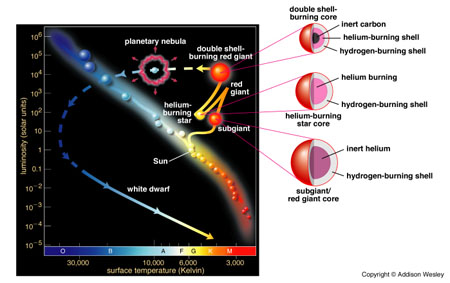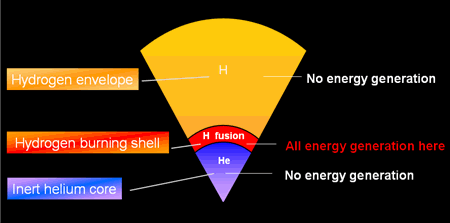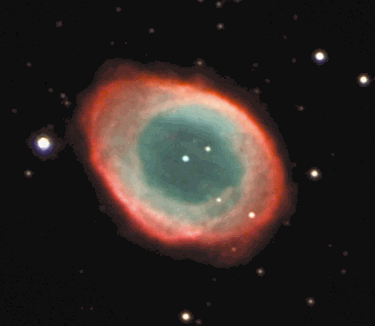Once the hydrogen fuel in the core of a low mass
star is used up, this marks the Main-Sequence
Turnoff Point. Hydrogen fusion is still occurring,
but in a shell that surrounds the core. All that is
left in the core is helium ash. In a nutshell, this
is what happens next:
- Hydrogen shell continues fusion
- Helium ash from hydrogen shell collects at
the core - the core has remnant helium ash from
prior core fusion
- Helium ash build as does
pressure and
temperature - helium flash then core helium
fusion
- hydrogen shell and helium core fusion
continues - core helium fusion ends soon (more
heat, faster burning)
- Ash in core now carbon, helium shell burning
begins, hydrogen shell burning continues
- Carbon ash compresses as outer layers
fluctuate
- Outer layers shed in planetary nebula
- Inert, compressed carbon core (White Dwarf)
remains

Now for the details. Once off of the
Main-Sequence, here is what the core of the star
looks like:

Image credit: Brooks/Cole Thomson Learning
The exact stages of evolutions are:
- Subgiant Branch (SGB) - hydrogen shell
burning - outer layers swell
- Red Giant Branch - helium ash core
compresses - increased hydrogen shell burning
- First Dredge Up - expanding atmosphere cools
star - stirs carbon, nitrogen and oxygen upward
- star heats up
- Core Helium Flash - continued compression
with added helium ash ignites helium - lots of
neutrinos
- Horizontal Branch - helium burning core -
hydrogen burning shell
- Pre AGB (Asymptotic Giant Branch) - outer
layers expand cooling the star - hydrogen shell
becomes dormant
- AGB - re-ignited hydrogen shell burning
(like a second Red Giant phase)
For stars under 4 Solar masses:
It is at this point that the outer layers of the
star expand; however this time they are lost -
expelled in the form of a planetary nebula.

(© 2005 Russell Croman,
www.rc-astro.com)
The end result of the thermal pulsing from the
helium and hydrogen shell burning is a planetary
nebula - like this image of the Ring nebula.
The remnant carbon core cools and contracts to
form a White Dwarf. The star at the center of the
Ring nebula (above) is a white dwarf.
| Interestingly, there is a limit to how
big a White Dwarf can be. The maximum mass a
White Dwarf (WD) can have is 1.44 Solar
masses. This is called the Chandrasekhar
limit - named after Subrahmanyan
Chandrasekhar, the astronomer who discovered
this limit. White dwarfs will eventually
cool to the point to where they will no
longer be visible. They will become Black
Dwarfs. |

(Image credit: Brooks/Cole Thomson Learning) |
There are no known black dwarfs indicating this
cool-off period can take millions of years.
If a white dwarf star is a part of a binary star
system, some interesting things can happen.

(Image credit: Brooks/Cole Thomson Learning) |
Because the white dwarf is pretty
massive (the mass of the
Sun in an object
the diameter of
Earth), the atmosphere of
the companion star can be accreted onto the
star. This can only happen when the
companion star enters its own red giant
phase. Once this happens, material is pulled
from the companion to the white dwarf. |
Once this happens, there are two choices:
If a thin layer of material collects in an
accretion disk around the white dwarf - dense enough
to initiate fusion - then the material will be
explosive ejecting a thin hydrogen shell. The white
dwarf remains to collect more material (the process
repeats itself).
This is called a Nova:

(Image credit: Brooks/Cole Thomson Learning)
However, if material collects rapidly enough on
the white dwarf, the mass of the white dwarf can
exceed the Chandrasekhar limit. If this happens,
there is only once choice: a complete annihilation
of the white dwarf and the accreted material.
This is called a Type 1a supernova, and is a very
dramatic event:

(Image credit: Brooks/Cole Thomson Learning)
What is unique about a Type 1a supernova is that
is occurs just past the Chandrasekhar limit of the
white dwarf. As such, the
luminosity is standard and
can be used an a distance ruler to distant galaxies
- just like
Cepheid variables are used to measure distance
to closer objects.
Classifications of Supernova:
| Type: |
Characteristics: |
Mechanism: |
|
1a |
No H lines, strong Si II lines |
Thermonuclear runaway on white dwarf |
| 1b |
No H lines, prominent He I lines |
Core collapse of massive star stripped
of hydrogen envelope |
| 1c |
No H, Si II or He I lines |
Core collapse of massive star stripped
of helium (and hydrogen) envelope |
| II-P |
H lines - flat light curve |
Core collapse of massive star |
| II-L |
H lines - no flat light curve |
Core collapse of massive star |
Back
to Top |

